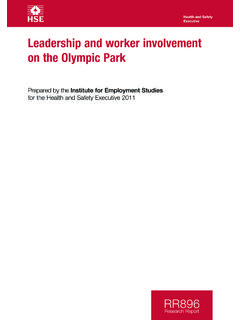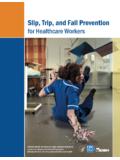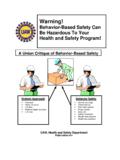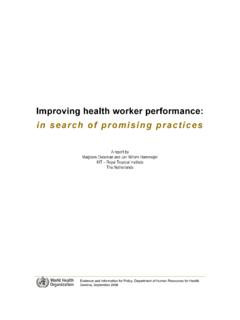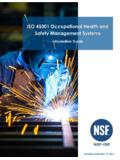Transcription of Worker involvement in health and safety: what …
1 Worker involvement in health and safety : what works? A report to the HSE prepared by Howard Fidderman and Karen McDonnell on behalf of the Royal Society for the Prevention of Accidents (RoSPA). 21 May 2010. 2. CONTENTS. Preface by Dr Paul Stollard 3. 1. Introduction 4. 2. A background to Worker involvement 6. 3. Methodology 11. 4. The main findings 12. 5. Points for the HSE to consider 16. 6. Tips on engaging workers 18. 7. CBES case study summary 20. 8. Highland Spring case study summary 23. 9. Livingston Designer Outlet case study summary 26. 10. Timbmet Shieldhall case study summary 65. 11. Recommendations 31. APPENDICES. 1. CBES case study 33. 2. Highland Spring case study 40. 3. Livingston Designer Outlet case study 54. 4. Timbmet Shieldhall case study 65. 5. Summary of workshop findings 75. 6. Notes from workshop one 77. 7. Notes from workshop two 81. 8. Notes from workshop three 83. 9. Questionnaire analysis 114. 10. Worker involvement questionnaire 136.
2 3. PREFACE. In 2009, the HSE launched a new strategy following extensive consultation across GB. The events we organised in Scotland were oversubscribed and generated lots of ideas. Underlying the strategy is the call to all sections of society to "Be Part of the Solution" in improving workplace health and safety . This is because we, and our local authority partners, recognise that, as regulators, we cannot do it all ourselves. The workforce in each industry has a key role to play and " Worker involvement " is one of the strategy's goals: specifically, to reinforce the promotion of Worker involvement and consultation in health and safety matters throughout unionised and non-unionised workplaces of all sizes. We have set this goal simply because the evidence suggests that involving workers has a positive effect on health and safety performance. But what is Worker involvement and what does it look like in practice, particularly where there is no trade union to structure and support it?
3 To try and answer these critical questions, the HSE in Scotland was delighted to be able engage RoSPA in a project to find out what works in Worker involvement ? . This report presents the findings from open and honest discussion with a diverse range of businesses as well as detailed case studies. It offers the HSE valuable material to promote the benefits of Worker involvement , which as can be inferred from these stories go much wider than health and safety . This complements the work we are currently doing to promote Worker involvement through subsidised training ( Safe and Sound at Work Do Your Bit ). Critically, it offers useful insights into how businesses that have yet to reap the rewards may go about introducing the right culture without bureaucracy or huge cost. The next step for us will be to use this work to help more businesses develop a relationship with their workforces based on trust, respect and cooperation all pre-requisites for the prevention of ill health and injury at work.
4 Dr Paul Stollard HSE Director Scotland 4. 1. INTRODUCTION. Worker involvement in health and safety is a key theme of the HSE's strategy for the UK's health and safety system, Be part of the solution1. The strategy, which was launched in 2009, recognises that the way forward for the health and safety system is for the HSE to work in partnership with stakeholders. Engaging with the workforce on health and safety -related issues . irrespective of the sphere of activity is fundamental to the success of the strategy. In 2009, HSE FOD Scotland engaged RoSPA to undertake an investigation of Worker involvement in health and safety within non-unionised workplaces in Scotland. The initiative builds on the evidence from research conducted by the HSE and others that organisations with properly involved unionised safety representatives achieved better health and safety performance than those without such representation. It also builds on the wider emerging employee engagement agenda in which positive relationships between employers and employees, and indeed between employees themselves, are key to improving productivity and enhancing working lives.
5 RoSPA conducted survey work and focus groups with a diverse range of organisations drawn from health and safety business networks in Scotland to help develop a self-sustaining what works in Worker involvement toolkit. Linking to the HSE's strategy, the investigation sought to identify examples of genuine management/workforce partnership based on trust, respect and cooperation, recognising that with such a partnership, a culture can evolve in which health and safety problems can be solved jointly and in which concerns, ideas and solutions are freely shared and acted upon. This approach ensured that the RoSPA initiative was underpinned by core HSE messages promulgating the positive benefits of Worker involvement , signposting relevant case studies, publications and sources of advice. Threads from the recently revised HSE Worker involvement website and the HSE's Safe and sound: do your bit campaign 2, and key messages from the MacLeod review of employee engagement3, have also been embedded in our attempt to identify leading edge Worker involvement initiatives in non-unionised workforces.
6 This report describes the background to this challenge, sets out and discusses main findings from the investigation and proposes next steps for helping organisations recognise the benefits of effective Worker involvement and how to go about improving their own practices. RoSPA is grateful to all those who contributed to this investigation through participation in focus groups and survey work. We would like to take this opportunity to express, in particular, our heartfelt thanks to the individuals who participated in the four case studies: Duncan McNicol at CBES, Jonathan Neale at Highland Spring, Karen Gray and Jim Bradley at Livingston Designer Outlet, and Alan Galloway at Timbmet. All four were incredibly generous with their time and kindness, as well as their willingness to share openly and honestly their experiences around Worker engagement. 1. HSE strategy details: 2. Information on the HSE campaign, Safe and sound at work: do your bit : 3. D MacLeod and N Clarke (2009), Engaging for success: enhancing performance through employee engagement , Background information: matters/strategies/employee-engagement.
7 See also: employee-engagement/?locale=en 5. 2. A BACKGROUND TO Worker involvement . The HSE's strategy for the health and safety system of the UK talks of genuine management workforce partnership based on trust, respect and cooperation and the combined involvement of management and health and safety representatives in inspections, investigations and risk assessments . While such cooperation may exist in well-run businesses with active safety representatives appointed by trades unions under the safety Representatives and safety Committees Regulations 1977, RoSPA's experience suggests there are few representatives of employee safety (RESs) elected in non-unionised workplaces despite the availability of this democratic option to employers under the health and safety (Consultation with Employees) Regulations 1996. It is RoSPA's opinion that real progress in relation to Worker involvement will be made through facilitating a participative approach to Worker involvement and sharing success as opposed to an approach that relies on invoking the 1996 Regulations.
8 Although trade unions insist the 1977 Regulations are the best path for consultation, the percentage of workplaces where unions are recognised has declined markedly since the 1970s, which means that the 1977 Regulations are irrelevant in these workplaces. Our research shows also that beneficial Worker involvement in health and safety is perfectly feasible in non- unionised workplaces, although in most cases it is likely to follow the employer's agenda and be confined to the implementation end of the spectrum rather than anything approaching joint planning and collaborative decision-making. (Union safety representatives are much more likely to be empowered to set agendas and be challenging.). The HSE, because of its regulatory role, has tended to focus on promoting employers' duties to consult, although this has been more a matter of persuasion and aspiration than formal enforcement. Although this provides a platform for employers to develop wider employee involvement , it is also now clear the current economic climate requires employers to have a clearly identified path to Worker involvement that is linked to their existing business framework.
9 Since the late 1990s, HSE-commissioned research linked to Worker involvement has sought to tease out some of the issues and explore potential barriers to strengthening and extending Worker involvement in day-to-day health and safety management, creating a foundation for further engaging workers on bigger questions via more structured consultation. Seeking to build on one of the cornerstones of successful health and safety management namely the establishment and maintenance of control and the observation made within HSG654 that organisations that perform well commercially often excel at managing health and safety , the HSE engaged the Keil Centre to explore the safety implications of self- managed teams5. The background to this research an international review of employee involvement stated that self- managed work teams (SMTs) were one of the most effective employee involvement techniques for fostering organisational success through improved quality, productivity and employee attitudes.
10 As with other business-related research, however (including, most recently, the MacLeod review), SMT literature tended not to link safety -related topics to the employee involvement equation. The Keil Centre's own survey work, however, identified numerous examples of how SMTs had led to improved employee involvement in health and safety and that it was evident that SMTs could be implemented in safety -critical industries without 4. HSE (1997), Successful health and safety management , HSG65, 5. HSE (1999), safety implications of self-managed teams , prepared by the Keil Centre, Offshore Technology Report OTO. 1999 025, 6. compromising health and safety , although they will only deliver results if: they are applied to appropriate tasks; the team is designed to enhance the performance of that task; and implementation is planned and thoroughly applied at the appropriate pace. The research identified the potential for focussed team-based activity linked to safety -related topics, a thread that has been developed in the Safe and sound: do your bit campaign.










